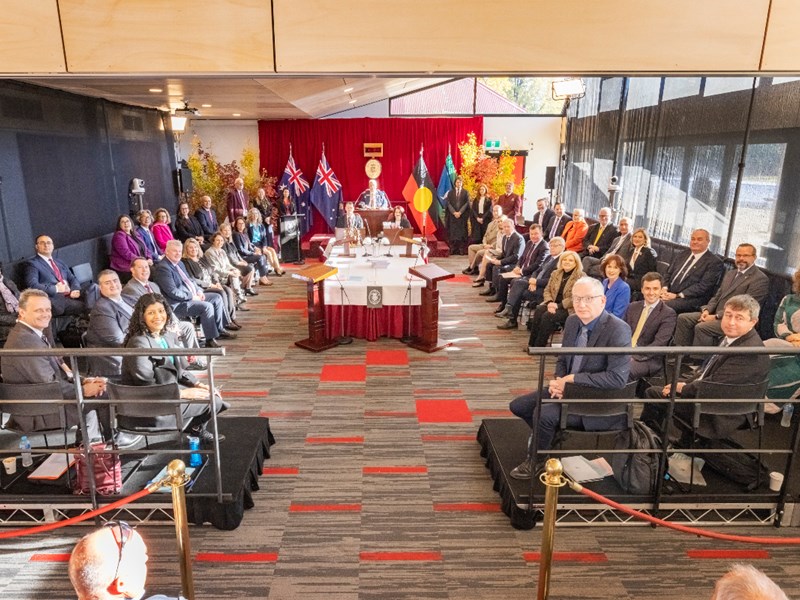Special Sittings
16 April 2024

What makes a sitting special? Is it the place, time, procedure or content? Is it none, or all of the above? With the regional sitting in Echuca just around the corner, we thought it was time to delve deeper into the specifics of special sittings.
We often call a sitting that does not follow standard parliamentary procedure and where there is something special planned a ‘special sitting’. If one of the houses were to sit in a different location (for example a regional sitting), hear from experts on a matter, or provide a public apology, these might all be considered a special sitting due to the required changes in the sitting schedule and the amount of planning needed.
Generally, with a speical sitting one house will organise and hold the sitting and may invite the other house to attend. This ensures that there are clear rules of procedure in place for the sitting; the rules of the house that initiated the sitting are the rules that are used. Ideas for special sittings can come from committees, members and ministers, department staff, experts and government and non-government. The proposition for any type of special sitting must be agreed to by the members, and any aspect of the sitting that will be different to a standard sitting day must be voted on by the house in advance. This may include scheduling a specific time for the special part of the sitting within a standard sitting day, changing when question time will occur, and permitting special guests to address the house.
Special: Regional sitting
Regional sittings, where parliament sits in a regional area, are considered important because of the connections and engagement they foster within the community and the way in which they make parliament accessible to those who usually might not be able to engage with parliament or its members. There have been ten regional sittings in the history of Victorian parliament.
A regional sitting, such as the one that will be happening in Echuca mid-April, is considered a special sitting because of the amount of planning and organisation involved in taking parliament (the people), and its processes, outside of the building, with the planning taking upwards of six months. Due to the logistics and space required for parliament to be able to sit in a regional area, the meeting location must be able to hold all 40 or 88 members (Legislaitve Council or Legislative Assembly), have enough space for a public gallery, along with sufficient accommodation options for all the staff attending. Therefore these sittings tend to happen in larger regional towns and often means that only one house sits in that location. For example, in 2012 the Legislative Council sat in Bendigo whilst the Legislative Assembly sat in Ballarat. Echuca was selected as the location for the Legislative Council to sit in 2024 due to the impact of the 2022 floods in the area and it also met the above criteria.
Like all special sittings, the idea for a regional sitting must originate as a motion from the house. If the order of business is to be altered during the sitting, that too must be done via a motion being agreed to. Finally, the Governor must issue a proclamation to enable the house to meet outside Parliament House.
Visit the Parliament of Victoria to learn more about past regional sittings.

A special guest speaker addresses the Legisalative Council Regional Sitting in Bright in 2022.
Special: Apology
If parliament is making a formal apology, this is considered a special sitting due to the changes to the sitting schedule for the day and the events at Parliament House that often accompany the apology.
Apologies are often suggested by a committee, who upon completing their research and submitting their report feel a formal apology is appropriate. When an apology is issued one house (usually the Legislative Assembly with government majority) will hold the special sitting, inviting the other house (the Legislative Council) to attend. Typically, the Premier issues the apology with the Leader of the Opposition and Leader of the Greens also given an opportunity to speak on the matter. Members show their support and approval of the apology by standing in silence. Occasionally, there may be a motion moved to ‘take note’ of an apology, allowing the topic to be raised in parliament on another day to provide more members the opportunity to speak to the apology.
Kind of special: Joint sitting
Joint sittings are kind of special, however, we have included them in this blog as a comparison rather than a focus. Joint sittings have their own unique rules of procedure that must be followed when both houses meet in this fashion, regardless of whether they are meeting in the Legislative Assembly or Legislative Council Chamber. Most joint sittings are held in the Legislative Assembly due to the number of seats.
Joint sittings can occur for various reasons, with a common reason being to elect someone to fill a Legislative Council seat. These vacancies are filled by parliament rather than going to a by-election, as the Council use proportional representation and it is not possible to work out the proportion if there is only one member being elected.
Visit the VEC website to learn more about proportional voting and keep your eye on the Parliament of Victoria website to watch the special Regional sitting live in Echuca on the Thursday 18 April.